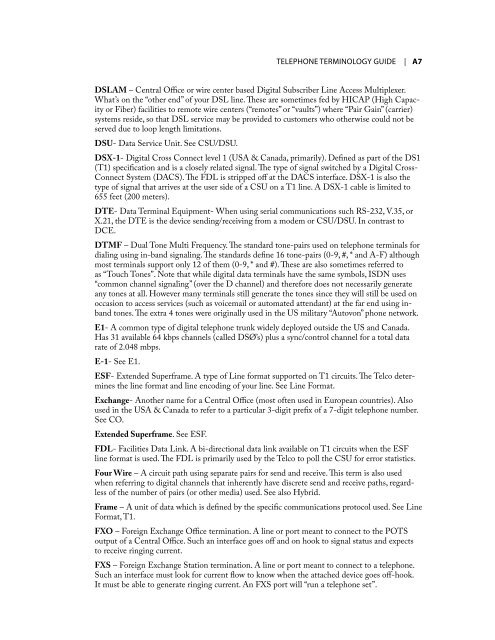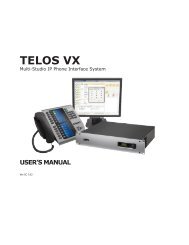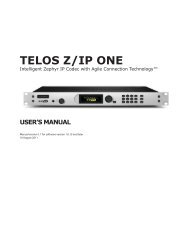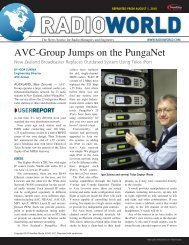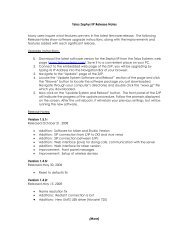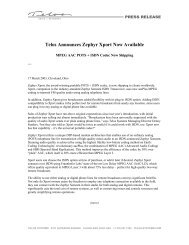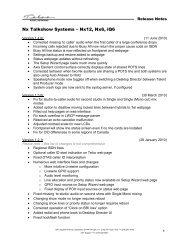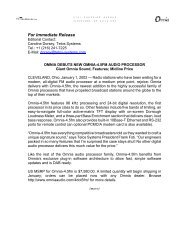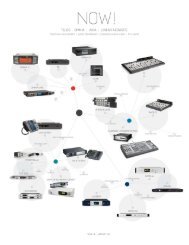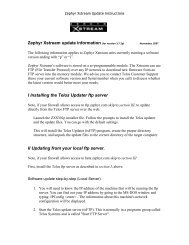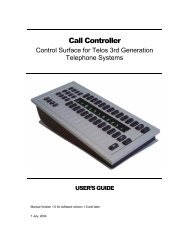Hx1-Hx2 Manual-1.4.1 - Telos
Hx1-Hx2 Manual-1.4.1 - Telos
Hx1-Hx2 Manual-1.4.1 - Telos
Create successful ePaper yourself
Turn your PDF publications into a flip-book with our unique Google optimized e-Paper software.
TelepHone TerMInoloGy GuIDe | A7<br />
DSLAM – Central Office or wire center based Digital Subscriber Line Access Multiplexer.<br />
What’s on the “other end” of your DSL line. These are sometimes fed by HICAP (High Capacity<br />
or Fiber) facilities to remote wire centers (“remotes” or “vaults”) where “Pair Gain” (carrier)<br />
systems reside, so that DSL service may be provided to customers who otherwise could not be<br />
served due to loop length limitations.<br />
DSU- Data Service Unit. See CSU/DSU.<br />
DSX-1- Digital Cross Connect level 1 (USA & Canada, primarily). Defined as part of the DS1<br />
(T1) specification and is a closely related signal. The type of signal switched by a Digital Cross-<br />
Connect System (DACS). The FDL is stripped off at the DACS interface. DSX-1 is also the<br />
type of signal that arrives at the user side of a CSU on a T1 line. A DSX-1 cable is limited to<br />
655 feet (200 meters).<br />
DTE- Data Terminal Equipment- When using serial communications such RS-232, V.35, or<br />
X.21, the DTE is the device sending/receiving from a modem or CSU/DSU. In contrast to<br />
DCE.<br />
DTMF – Dual Tone Multi Frequency. The standard tone-pairs used on telephone terminals for<br />
dialing using in-band signaling. The standards define 16 tone-pairs (0-9, #, * and A-F) although<br />
most terminals support only 12 of them (0-9, * and #). These are also sometimes referred to<br />
as “Touch Tones”. Note that while digital data terminals have the same symbols, ISDN uses<br />
“common channel signaling” (over the D channel) and therefore does not necessarily generate<br />
any tones at all. However many terminals still generate the tones since they will still be used on<br />
occasion to access services (such as voicemail or automated attendant) at the far end using inband<br />
tones. The extra 4 tones were originally used in the US military “Autovon” phone network.<br />
E1- A common type of digital telephone trunk widely deployed outside the US and Canada.<br />
Has 31 available 64 kbps channels (called DSØ’s) plus a sync/control channel for a total data<br />
rate of 2.048 mbps.<br />
E-1- See E1.<br />
ESF- Extended Superframe. A type of Line format supported on T1 circuits. The Telco determines<br />
the line format and line encoding of your line. See Line Format.<br />
Exchange- Another name for a Central Office (most often used in European countries). Also<br />
used in the USA & Canada to refer to a particular 3-digit prefix of a 7-digit telephone number.<br />
See CO.<br />
Extended Superframe. See ESF.<br />
FDL- Facilities Data Link. A bi-directional data link available on T1 circuits when the ESF<br />
line format is used. The FDL is primarily used by the Telco to poll the CSU for error statistics.<br />
Four Wire – A circuit path using separate pairs for send and receive. This term is also used<br />
when referring to digital channels that inherently have discrete send and receive paths, regardless<br />
of the number of pairs (or other media) used. See also Hybrid.<br />
Frame – A unit of data which is defined by the specific communications protocol used. See Line<br />
Format, T1.<br />
FXO – Foreign Exchange Office termination. A line or port meant to connect to the POTS<br />
output of a Central Office. Such an interface goes off and on hook to signal status and expects<br />
to receive ringing current.<br />
FXS – Foreign Exchange Station termination. A line or port meant to connect to a telephone.<br />
Such an interface must look for current flow to know when the attached device goes off-hook.<br />
It must be able to generate ringing current. An FXS port will “run a telephone set”.


